Detecting Geothermal Anomalies Using Multi-Temporal Thermal Infrared Remote Sensing Data in the Damxung–Yangbajain Basin, Qinghai–Tibet Plateau
Abstract
:1. Introduction
2. Geological Setting
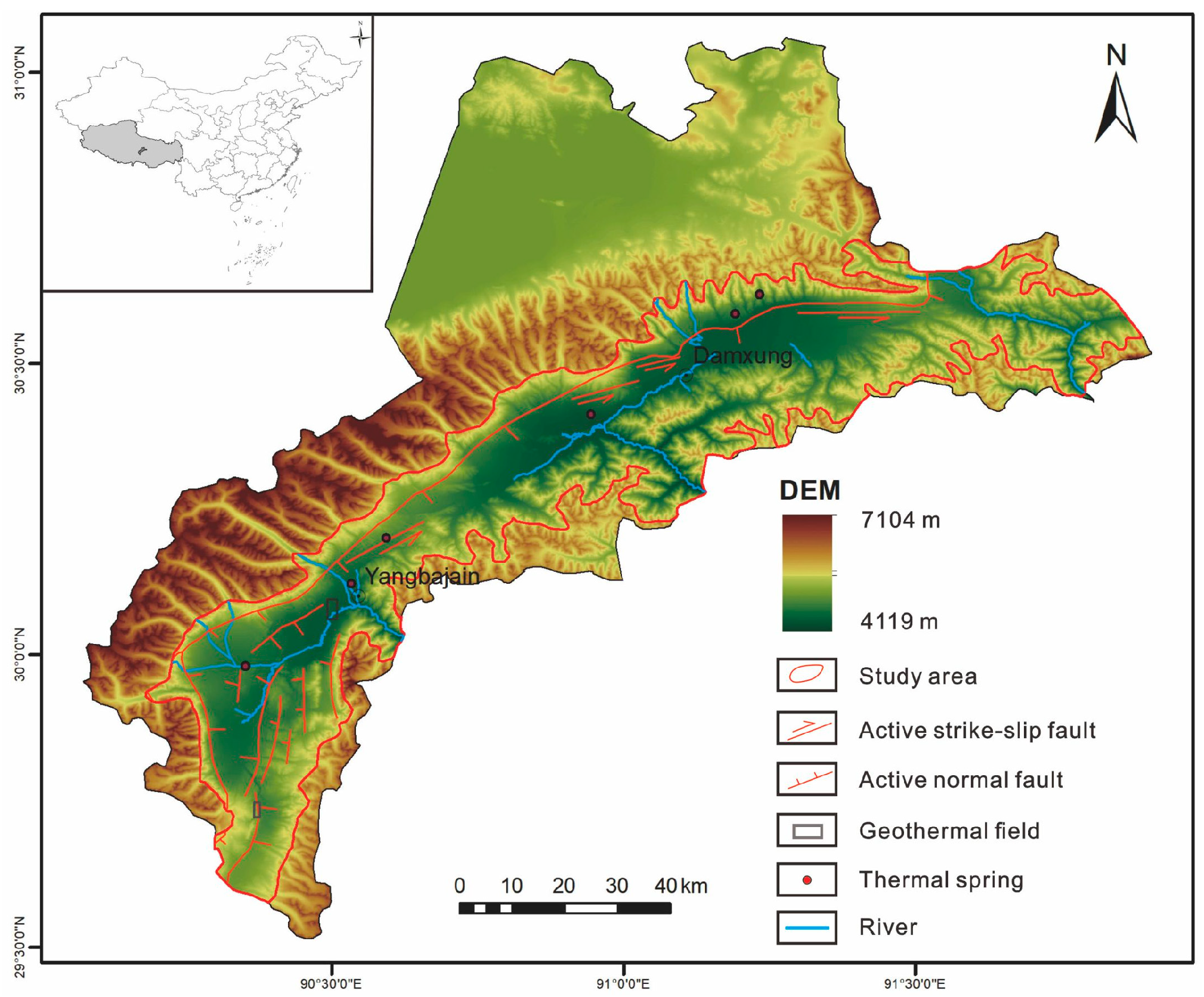
3. Materials and Methods
3.1. Materials
3.1.1. Landsat 8 Data
3.1.2. Google Earth Engine
3.2. Methods
3.2.1. LST Computation
3.2.2. Geothermal Anomalies Extraction from LST
4. Results
4.1. Land Surface Temperature (LST) Results
4.1.1. Land Surface Temperature
4.1.2. Annual Mean Winter LST
4.1.3. Water Body Removal
- (1)
- Water body extraction
- (2)
- Water body removal
4.1.4. Altitude Correction
4.2. Geothermal Anomalies Extraction
4.2.1. Extraction of LST Anomaly Areas
4.2.2. LST Changes of Thermal Springs
4.2.3. Geothermal Potential Mapping
5. Discussion
5.1. Uncertainties of the Proposed Method
- (1)
- The method has a limitation due to the partial availability of winter time series data, resulting in the estimation of different locations with varying time series structures. For instance, certain pixels may possess comprehensive time series, while others rely on only a limited number of observations over the study period. However, the utilization of sufficiently long time series, as demonstrated in this study, significantly reduces the likelihood of pixels containing insufficient LST data.
- (2)
- While TIR remote sensing technology is a useful method for identifying large-scale geothermal anomalies, it has limitations in accurately determining the location of geothermal resources. As a result, it can provide a general understanding of the current state and dynamic changes of geothermal activity in the region, but it cannot provide precise information on the location of geothermal resources.
5.2. Mechanism of Geothermal Anomalies
6. Conclusions
Author Contributions
Funding
Data Availability Statement
Acknowledgments
Conflicts of Interest
References
- Chan, H.; Chang, C.; Dao, P.D. Geothermal Anomaly Mapping Using Landsat ETM+ Data in Ilan Plain, Northeastern Taiwan. Pure Appl. Geophys. 2018, 175, 303–323. [Google Scholar] [CrossRef]
- Hou, J.; Cao, M.; Liu, P. Development and utilization of geothermal energy in China: Current practices and future strategies. Renew. Energy 2018, 125, 401–412. [Google Scholar] [CrossRef]
- Li, D.; Wang, Y. Major Issues of Research and Development of Hot Dry Rock Geothermal Energy. Earth Sci. J. China Univ. Geosci. 2015, 40, 1858–1869. [Google Scholar]
- Li, K.; Bian, H.; Liu, C.; Zhang, D.; Yang, Y. Comparison of geothermal with solar and wind power generation systems. Renew. Sustain. Energy Rev. 2015, 42, 1464–1474. [Google Scholar] [CrossRef]
- Guan, X. The situation, measures & suggestions on the exploration and utilization of geothermal resources. China Min. Mag. 2010, 19, 7–9. [Google Scholar]
- Zhang, C.; Jiang, G.; Jia, X.; Li, S.; Zhang, S.; Hu, D.; Hu, S.; Wang, Y. Parametric study of the production performance of an enhanced geothermal system: A case study at the Qiabuqia geothermal area, northeast Tibetan plateau. Renew. Energy 2019, 132, 959–978. [Google Scholar] [CrossRef]
- Zhang, C.; Wang, X.; Jiang, C.; Zhang, H. Numerical simulation of geothermal energy production from hot dry rocks under the interplay between the heterogeneous fracture and stimulated reservoir volume. J. Clean. Prod. 2023, 414, 137724. [Google Scholar] [CrossRef]
- Zhang, L.X.; Pang, M.Y.; Han, J.; Li, Y.Y.; Wang, C.B. Geothermal power in China: Development and performance evaluation. Renew. Sustain. Energy Rev. 2019, 116, 109431. [Google Scholar] [CrossRef]
- Wang, S.; Lu, C.; Nan, D.; Hu, X.; Shao, J. Geothermal resources in Tibet of China: Current status and prospective development. Environ. Earth Sci. 2017, 76, 239. [Google Scholar] [CrossRef]
- Abubakar, A.J.A.; Hashim, M.; Pour, A.B. Remote sensing satellite imagery for prospecting geothermal systems in an aseismic geologic setting: Yankari Park, Nigeria. Int. J. Appl. Earth Obs. Geoinf. 2019, 80, 157–172. [Google Scholar] [CrossRef]
- Chao, J.; Zhao, Z.; Lai, Z.; Xu, S.; Liu, J.; Li, Z.; Zhang, X.; Chen, Q.; Yang, H.; Zhao, X. Detecting geothermal anomalies using Landsat 8 thermal infrared remote sensing data in the Ruili Basin, Southwest China. Environ. Sci. Pollut. Res. 2022, 30, 32065–32082. [Google Scholar] [CrossRef] [PubMed]
- Bezerra, F.G.S.; Aguiar, A.P.D.; Alvalá, R.C.S.; Giarolla, A.; Bezerra, K.R.A.; Lima, P.V.P.S.; Do Nascimento, F.R.; Arai, E. Analysis of areas undergoing desertification, using EVI2 multi-temporal data based on MODIS imagery as indicator. Ecol. Indic. 2020, 117, 106579. [Google Scholar] [CrossRef]
- Wu, Z.; Lei, S.; Bian, Z.; Huang, J.; Zhang, Y. Study of the desertification index based on the albedo-MSAVI feature space for semi-arid steppe region. Environ. Earth Sci. 2019, 78, 232. [Google Scholar] [CrossRef]
- Wang, Y.; Pang, Z. Heat flux in volcanic and geothermal areas: Methods, principles, applications and future directions. Gondwana Res. 2022; in press. [Google Scholar] [CrossRef]
- Xiong, Y.; Chen, F.; Huang, S. Application of remote sensing technique to the identification of geothermal anomaly in Tengchong area, southwest China. J. Chengdu Univ. Technol. (Sci. Technol. Ed.) 2016, 43, 109–118. [Google Scholar]
- Liu, S.; Ye, C.; Sun, Q.; Xu, M.; Duan, Z.; Sheng, H.; Wan, J. Detection of Geothermal Anomaly Areas with Spatio-Temporal Analysis Using Multitemporal Remote Sensing Data. IEEE J. Sel. Top. Appl. Earth Obs. Remote Sens. 2021, 14, 4866–4878. [Google Scholar] [CrossRef]
- Weldeyohannes, T.T.; Hailu, B.T.; Muluneh, A.A.; Kidane, T. Detection of geothermal anomalies in the Northern Lake Abaya geothermal field, Main Ethiopian Rift. J. Volcanol. Geotherm. Res. 2022, 430, 107638. [Google Scholar] [CrossRef]
- Zhang, A.; Zhang, X. Land surface temperature retrieved from Landsat-8 and comparison with MODIS temperature product. J. Beijing For. Univ. 2019, 41, 1–13. [Google Scholar]
- Sekertekin, A.; Arslan, N. Monitoring thermal anomaly and radiative heat flux using thermal infrared satellite imagery—A case study at Tuzla geothermal region. Geothermics 2019, 78, 243–254. [Google Scholar] [CrossRef]
- Van der Meer, F.; Hecker, C.; van Ruitenbeek, F.; van der Werff, H.; de Wijkerslooth, C.; Wechsler, C. Geologic remote sensing for geothermal exploration: A review. Int. J. Appl. Earth Obs. Geoinf. 2014, 33, 255–269. [Google Scholar] [CrossRef]
- Qin, Q.; Zhang, N.; Nan, P.; Chai, L. Geothermal area detection using Landsat ETM+ thermal infrared data and its mechanistic analysis—A case study in Tengchong, China. Int. J. Appl. Earth Obs. Geoinf. 2011, 13, 552–559. [Google Scholar] [CrossRef]
- Westermann, S.; Langer, M.; Boike, J. Spatial and temporal variations of summer surface temperatures of high-arctic tundra on Svalbard—Implications for MODIS LST based permafrost monitoring. Remote Sens. Environ. 2011, 115, 908–922. [Google Scholar] [CrossRef]
- Li, H.; Peng, S.; Qiao, W.; Lin, M.; Wang, Z.; Tian, L. The distribution and activity of Cenozoic magma chamber in Tengchong volcano area deduced from the MODIS multi-temporal monthly night LST data. Acta Petrol. Sin. 2011, 27, 2873–2882. [Google Scholar]
- Li, Z.L.; Wu, H.; Duan, S.B.; Zhao, W.; Ren, H.; Liu, X.; Leng, P.; Tang, R.; Ye, X.; Zhu, J.; et al. Satellite Remote Sensing of Global Land Surface Temperature: Definition, Methods, Products, and Applications. Rev. Geophys. 2023, 61, e2022RG000777. [Google Scholar] [CrossRef]
- Heasler, H.; Jaworowski, C. Hydrothermal monitoring of Norris Geyser Basin, Yellowstone National Park, USA, using airborne thermal infrared imagery. Geothermics 2018, 72, 24–46. [Google Scholar] [CrossRef]
- Zhang, Z. Temperature Inversion of Remote Sensing Data Zone and Investigation of Geothermal Anomaly in Yangbajing Region of Tibet. Master’s Thesis, Chengdu University of Technology, Chengdu, China, 2010; 54p. [Google Scholar]
- Yang, J.; Wen, X.; Tan, H. Land surface temperature using remote sensing data inversion and prediction of geothermal anomaly area in Nimu, Xizang(Tibet). Geol. Rev. 2021, 67, 1770–1779. [Google Scholar]
- Chen, Z.; Dong, Q.; Chen, J.; Zhao, W.; Jiang, L.; Zhang, G.; Feng, T.; Wang, D.; Bi, X.; Bian, M.; et al. Research on Quantitative Prediction and Evaluation of Geothermal Anomaly Area in Qamdo-Nyingchi Section of Sichuan-Tibet Railway. Remote Sens. Technol. Appl. 2021, 36, 1368–1378. [Google Scholar]
- Li, J.; Zhang, Y. GIS based information model for assessment of geothermal potential: Case study of Tengchong county, southwest China. J. Eng. Geol. 2018, 26, 540–550. [Google Scholar]
- Yan, B.; Qiu, S.; Xiao, C.; Liang, X. Potential Geothermal Fields Remote Sensing Identification Changbai Mountain Basalt Area. J. Jilin Univ. (Earth Sci. Ed.) 2017, 47, 1819–1828. [Google Scholar]
- Zhang, F. Remote Prediction of Geothermal Resource Potential in the Changbai Mountain Area. Ph.D. Thesis, Jilin University, Jilin, China, 2016; 68p. [Google Scholar]
- Xin, L.; Liu, X.; Zhang, B. Land surface temperature retrieval and geothermal resources prediction by remote sensing image: A case study in the Shijiazhuang area, Hebei province. J. Geomech. 2021, 27, 40–51. [Google Scholar]
- Gao, Y. Geothermal Detection Based on Multi-Source Thermal Infrared Remote Sensing Technology. Master’s Thesis, China University of Mining and Technology, Beijing, China, 2022; 86p. [Google Scholar]
- Darge, Y.M.; Hailu, B.T.; Muluneh, A.A.; Kidane, T. Detection of geothermal anomalies using Landsat 8 TIRS data in Tulu Moye geothermal prospect, Main Ethiopian Rift. Int. J. Appl. Earth Obs. Geoinf. 2019, 74, 16–26. [Google Scholar] [CrossRef]
- Romaguera, M.; Vaughan, R.G.; Ettema, J.; Izquierdo-Verdiguier, E.; Hecker, C.A.; van der Meer, F.D. Detecting geothermal anomalies and evaluating LST geothermal component by combining thermal remote sensing time series and land surface model data. Remote Sens. Environ. 2018, 204, 534–552. [Google Scholar] [CrossRef]
- Hewson, R.; Mshiu, E.; Hecker, C.; van der Werff, H.; van Ruitenbeek, F.; Alkema, D.; van der Meer, F. The application of day and night time ASTER satellite imagery for geothermal and mineral mapping in East Africa. Int. J. Appl. Earth Obs. Geoinf. 2020, 85, 101991. [Google Scholar] [CrossRef]
- Gemitzi, A.; Dalampakis, P.; Falalakis, G. Detecting geothermal anomalies using Landsat 8 thermal infrared remotely sensed data. Int. J. Appl. Earth Obs. Geoinf. 2021, 96, 102283. [Google Scholar] [CrossRef]
- Lago González, D.; Rodríguez-Gonzálvez, P. Detection of Geothermal Potential Zones Using Remote Sensing Techniques. Remote Sens. 2019, 11, 2403. [Google Scholar] [CrossRef]
- Yang, G.; Tang, Y.; Lei, D.; Hu, Q.; Wu, J. Holocene activity and seismic hazard analysis of faults in Damxung, Tibet. Acta Geophys. 2020, 68, 597–604. [Google Scholar] [CrossRef]
- Zhang, Y.; Tan, H.; Cong, P.; Shi, Z.; Yang, J. Enrichment Mechanism of B, Li, Rb, and Cs in the Geothermal System of Yangbajin-Dangxiong Rift, Tibet. Acta Sedimentol. Sin. 2022, 1–18. [Google Scholar]
- Wu, Z.; Zhao, X.; Wu, Z.; Jiang, W.; Hu, D. Quaternary geology and faulting in the Damxung-Yangbajain basin, southern Tibet. J. Geomech. 2006, 12, 305–316. [Google Scholar]
- Feng, X. Basic Characteristics of the Damxung-Yangbajain Active Tectonic Zone in Tibet and Its Influence on the Safety of the Qing-Zang Railway. Acta Geosci. Sin. 2007, 173–180. [Google Scholar] [CrossRef]
- Wu, Z.; Hu, D.; Liu, Q.; Xia, H.; Yan, X. The Formation and Evolution of Tectonic Landform of Damxung Area in Central Tibetan Plateau. Acta Geosci. Sin. 2002, 23, 423–428. [Google Scholar]
- Jiao, Q. Study of the Active Faults Using Remote Sensing and Activity Analysis. Master’s Thesis, Shandong University of Science and Technology, Qingdao, China, 2011; 100p. [Google Scholar]
- Wang, Y.; Li, L.; Wen, H.; Hao, Y. Geochemical evidence for the nonexistence of supercritical geothermal fluids at the Yangbajing geothermal field, southern Tibet. J. Hydrol. 2022, 604, 127243. [Google Scholar] [CrossRef]
- Liu, Z. The Forming Mechanism of Typical High-Temperature Geothermal Systems in Nimu-Naqu Geothermal Belt, Tibet. Ph.D. Thesis, Chinese Academy of Geological Science, Beijing, China, 2014; 111p. [Google Scholar]
- Zuo, J.; Wu, Z.; Ha, G.; Hu, M.; Zhou, C.; Gai, H. Spatial variation of nearly NS-trending normal faulting in the southern Yadong-Gulu rift, Tibet: New constraints from the Chongba Yumtso fault, Duoqing Co graben. J. Struct. Geol. 2021, 144, 104256. [Google Scholar] [CrossRef]
- Sun, H. Land Surface Temperature Retrieval Based on Thermal Infrared Remote Sensing Data and Research on the Exploring Methodology of Geothermal Resources in Dandong-Liaoyang. Master’s Thesis, Jilin University, Changchun, China, 2018; 73p. [Google Scholar]
- Duan, S.; Ru, C.; Li, Z.; Wang, M.; Xu, H.; Li, H.; Wu, P.; Zhan, W.; Zhou, J.; Zhao, W.; et al. Reviews of methods for land surface temperature retrieval from Landsat thermal infrared data. Natl. Remote Sens. Bull. 2021, 25, 1591–1617. [Google Scholar] [CrossRef]
- Wang, K.; Jiang, Q.; Yu, D.; Yang, Q.; Wang, L.; Han, T.; Xu, X. Detecting daytime and nighttime land surface temperature anomalies using thermal infrared remote sensing in Dandong geothermal prospect. Int. J. Appl. Earth Obs. Geoinf. 2019, 80, 196–205. [Google Scholar] [CrossRef]
- Hu, D.; Qiao, K.; Wang, X.; Zhao, L.; Ji, G. Land Surface Temperature Retrieval from Landsat 8 TIRS Data Using Mono-window Algorithm. Geomat. Inf. Sci. Wuhan Univ. 2017, 42, 869–876. [Google Scholar]
- Gorelick, N.; Hancher, M.; Dixon, M.; Ilyushchenko, S.; Thau, D.; Moore, R. Google Earth Engine: Planetary-scale geospatial analysis for everyone. Remote Sens. Environ. 2017, 202, 18–27. [Google Scholar] [CrossRef]
- Xu, H.; Liu, C.; Wang, J.; Qi, S. Study on Extraction of Citrus Orchard in Gannan Region Based on Google Earth Engine Platform. J. Geo-Inf. Sci. 2018, 20, 396–404. [Google Scholar]
- Ye, W.; Chen, Y.; Lu, Y.; Wu, P. Spatio-temporal variation of land surface temperature and land cover responses in different seasons in Shengjin Lake wetland during 2000—2019 based on Google Earth Engine. Remote Sens. Land Resour. 2021, 33, 228–236. [Google Scholar]
- Song, T.; Duan, Z.; Liu, J.; Shi, J.; Yan, F.; Sheng, S.; Huang, J.; Wu, W. Comparison of four algorithms to retrieve land surface temperature using Landsat 8 satellite. J. Remote Sens. 2015, 19, 451–464. [Google Scholar]
- Xu, H. Retrieval of the reflectance and land surface temperature of the newly-launched Landsat 8 satellite. Chin. J. Geophys. 2015, 58, 741–747. [Google Scholar]
- Yang, X. Research on the Single-Channel Algorithm for Land Surface Temperature Retrieval from Landsat8 Data. Master’s Thesis, China University of Geosciences, Beijing, China, 2015; 56p. [Google Scholar]
- Qin, Z.; Karnieli, A.; Berliner, P. A mono-window algorithm for retrieving land surface temperature from Landsat TM data and its application to the Israel-Egypt border region. Int. J. Remote Sens. 2010, 22, 3719–3746. [Google Scholar] [CrossRef]
- Qin, Z.; Zhang, M.; Arnon, K.; Pedro, B. The mono-window algorithm for calculating land surface temperature using land satellite TM6 data. Acta Geogr. Sin. 2001, 456–466. [Google Scholar] [CrossRef]
- Avdan, U.; Jovanovska, G. Algorithm for Automated Mapping of Land Surface Temperature Using LANDSAT 8 Satellite Data. J. Sens. 2016, 2016, 1480307. [Google Scholar] [CrossRef]
- Parastatidis, D.; Mitraka, Z.; Chrysoulakis, N.; Abrams, M. Online Global Land Surface Temperature Estimation from Landsat. Remote Sens. 2017, 9, 1208. [Google Scholar] [CrossRef]
- Gutiérrez, F.J.; Lemus, M.; Parada, M.A.; Benavente, O.M.; Aguilera, F.A. Contribution of ground surface altitude difference to thermal anomaly detection using satellite images: Application to volcanic/geothermal complexes in the Andes of Central Chile. J. Volcanol. Geotherm. Res. 2012, 237–238, 69–80. [Google Scholar] [CrossRef]
- Vaughan, R.G.; Keszthelyi, L.P.; Lowenstern, J.B.; Jaworowski, C.; Heasler, H. Use of ASTER and MODIS thermal infrared data to quantify heat flow and hydrothermal change at Yellowstone National Park. J. Volcanol. Geotherm. Res. 2012, 233–234, 72–89. [Google Scholar] [CrossRef]
- Jiang, W.; Wu, J.; Gu, L.; Yang, B.; Chen, Q.; Liu, X. Research on Underground Coal Fire Monitoring Method Based on Night Thermal Infrared Spectroscopy. Spectrosc. Spectr. Anal. 2011, 31, 357–361. [Google Scholar]
- Xu, Z.; Xu, S.; Zhang, S. Hydro-Geochemistry of Anning Geothermal Field and Flow Channels Inferring of Upper Geothermal Reservoir. Earth Sci. 2021, 46, 4175–4187. [Google Scholar]
- Ren, Z.; Liu, R.; Ren, W.; Qi, K.; Yang, G.; Cui, J.; Yang, P.; Zhang, Y. Distribution of geothermal field and its controlling factors in the Weihe basin. Acta Geol. Sin. 2020, 94, 1938–1949. [Google Scholar]
- Zhou, T.; Wang, Z.; Qin, H.; Zeng, Y. Remote sensing extraction of geothermal anomaly based on terrain effect correction. J. Remote Sens. 2020, 24, 265–276. [Google Scholar] [CrossRef]
- Zhou, A.; Zhao, Y.; Guo, J.; Zhang, N. Study of Geothermal Extraction Scheme of Hot Dry Rock in Tibetan Yangbajing Region. Chin. J. Rock Mech. Eng. 2010, 29 (Suppl. 2), 4089–4095. [Google Scholar]
- Jiang, G.; Hu, S.; Cui, T.; Qian, C.; Liu, F.; Zhang, C.; Wang, Z.; Wang, Y.; Hou, T.; Tian, Y. Thermal structure beneath Changbaishan Volcano, northeastern Asia: New insights from temperature logging and numerical modelling. Geophys. J. Int. 2023, 235, 1228–1239. [Google Scholar] [CrossRef]
- Jiang, G.; Hu, S.; Shi, Y.; Zhang, C.; Wang, Z.; Hu, D. Terrestrial heat flow of continental China: Updated dataset and tectonic implications. Tectonophysics 2019, 753, 36–48. [Google Scholar] [CrossRef]
- Jiang, G.; Tian, Y.; Lv, Q.; Sandiford, M.; Shi, Y.; Zou, C.; Ma, F.; Deng, C.; He, L.; Hu, S. Ground Surface Temperature History Since the Last Glacial Maximum in Northeast Asia: Reconstructions from the Borehole Geotherms of the International Continental Scientific Drilling Program. Geophys. Res. Lett. 2023, 50, e2023GL103055. [Google Scholar] [CrossRef]
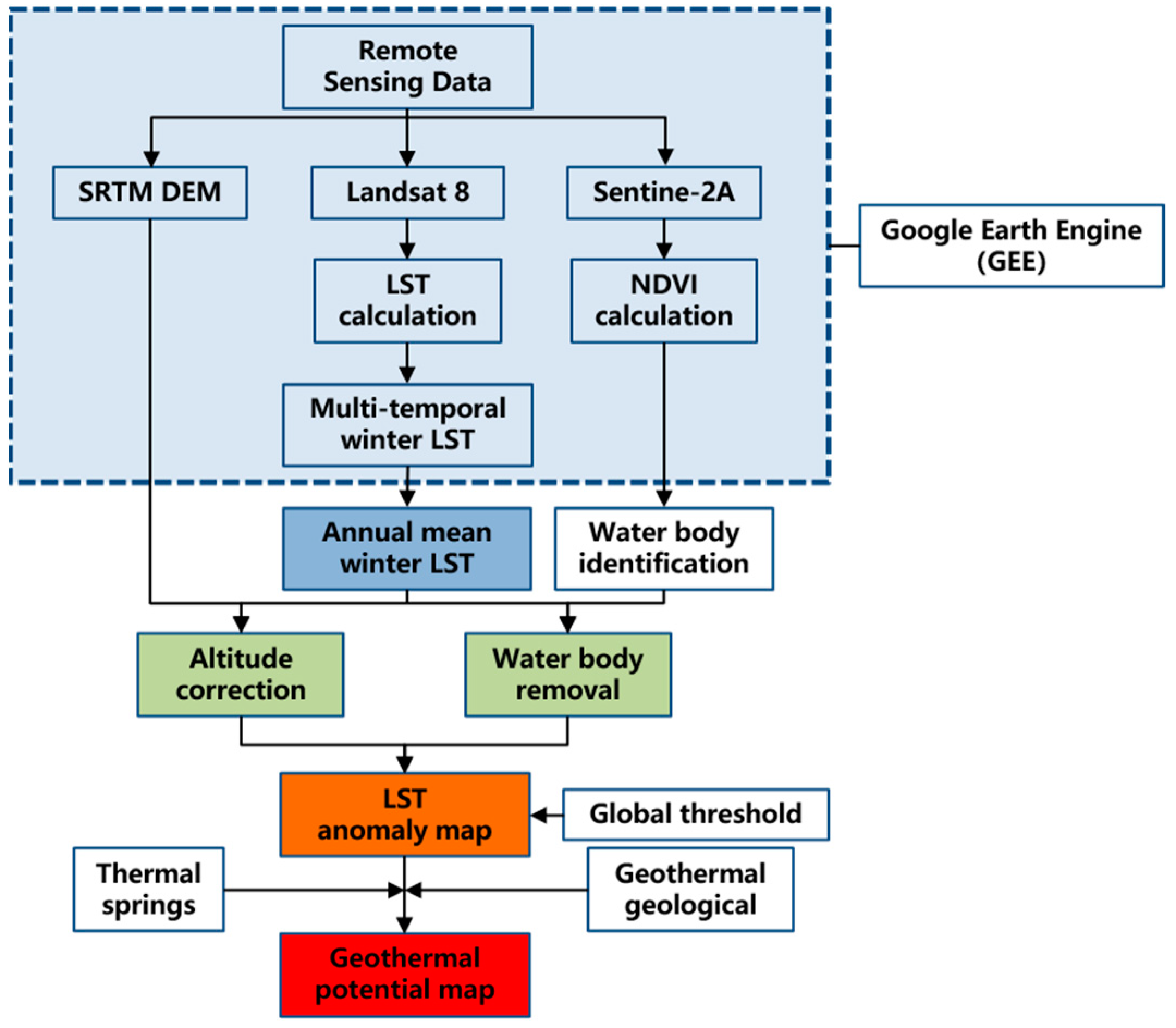
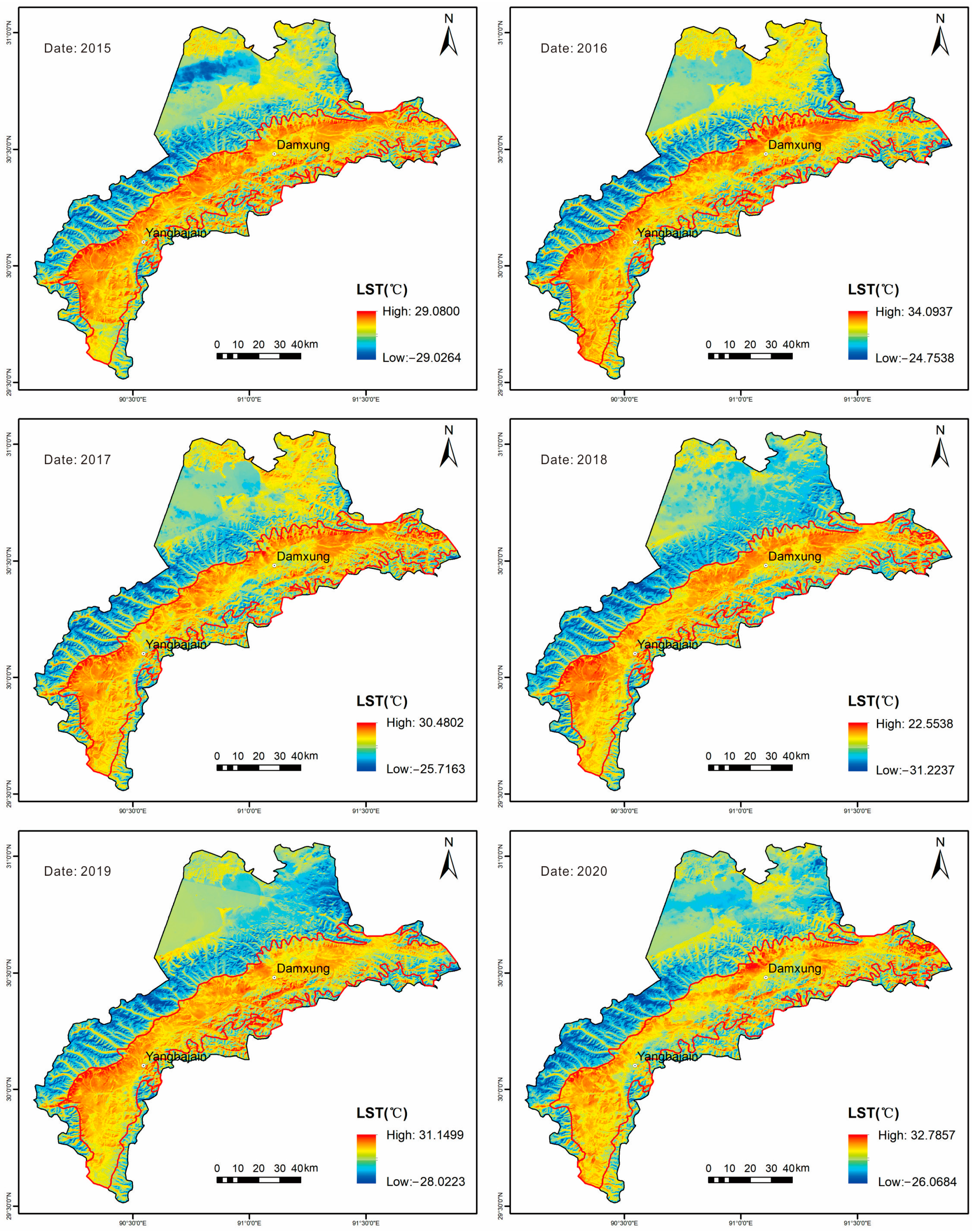


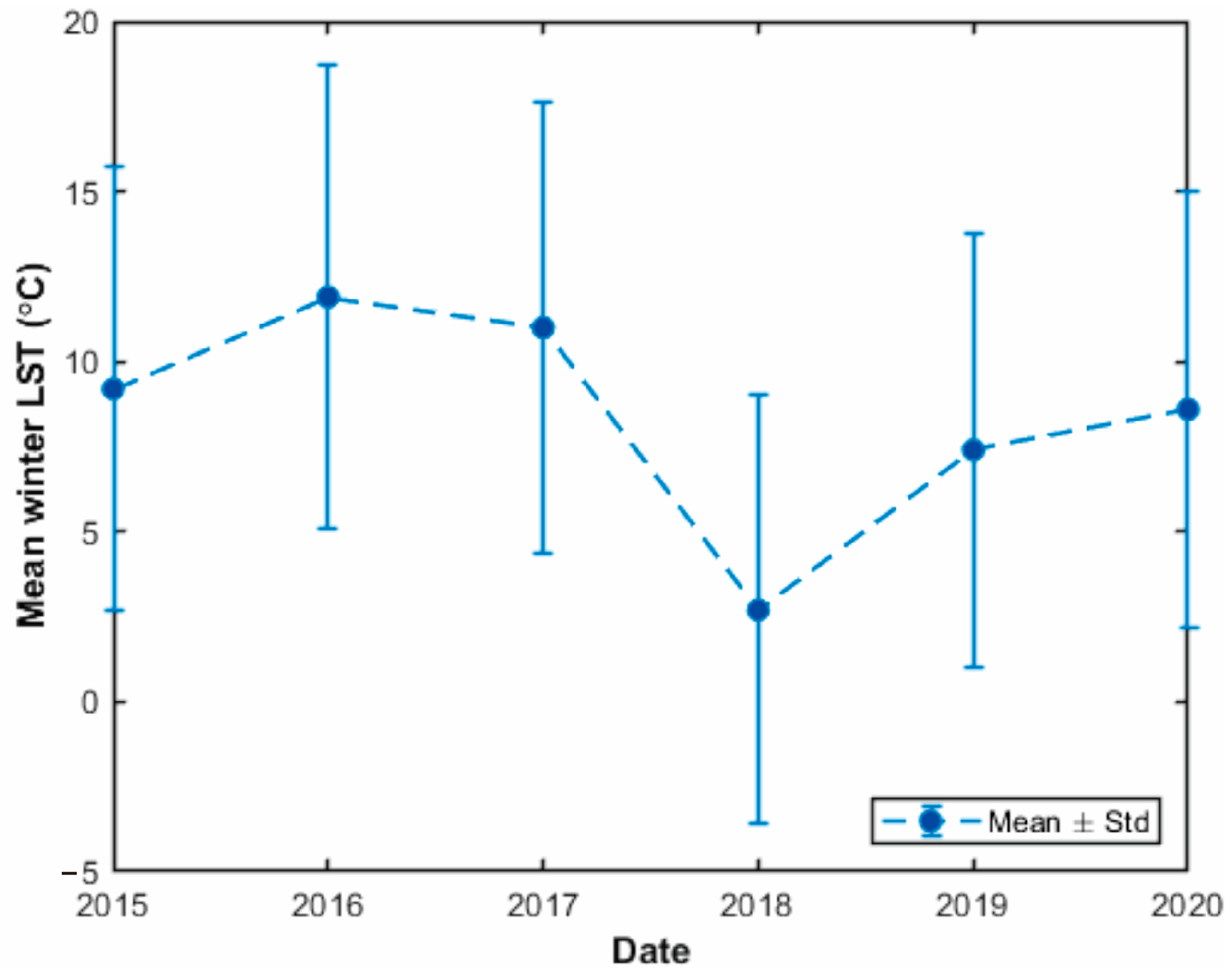
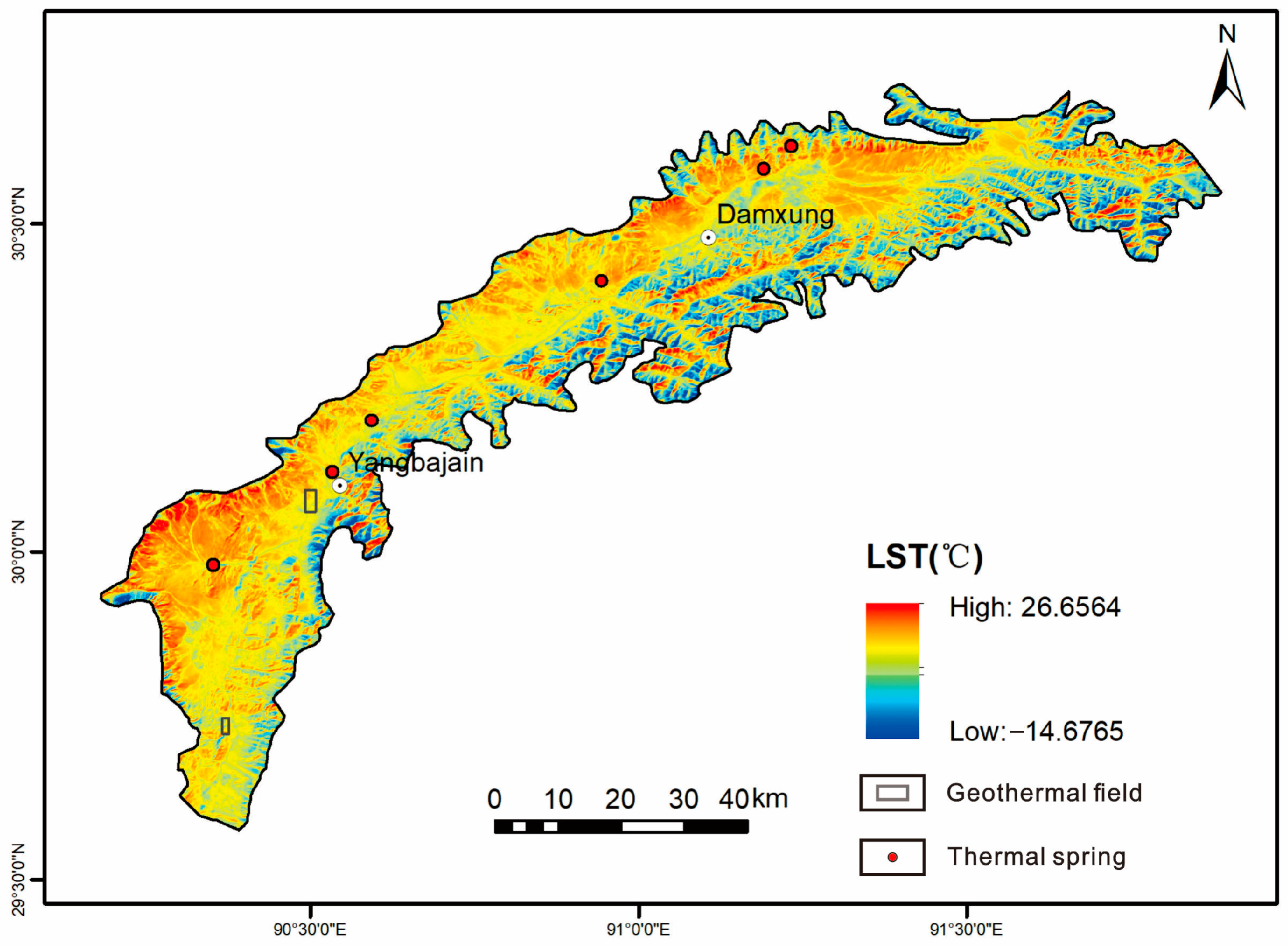
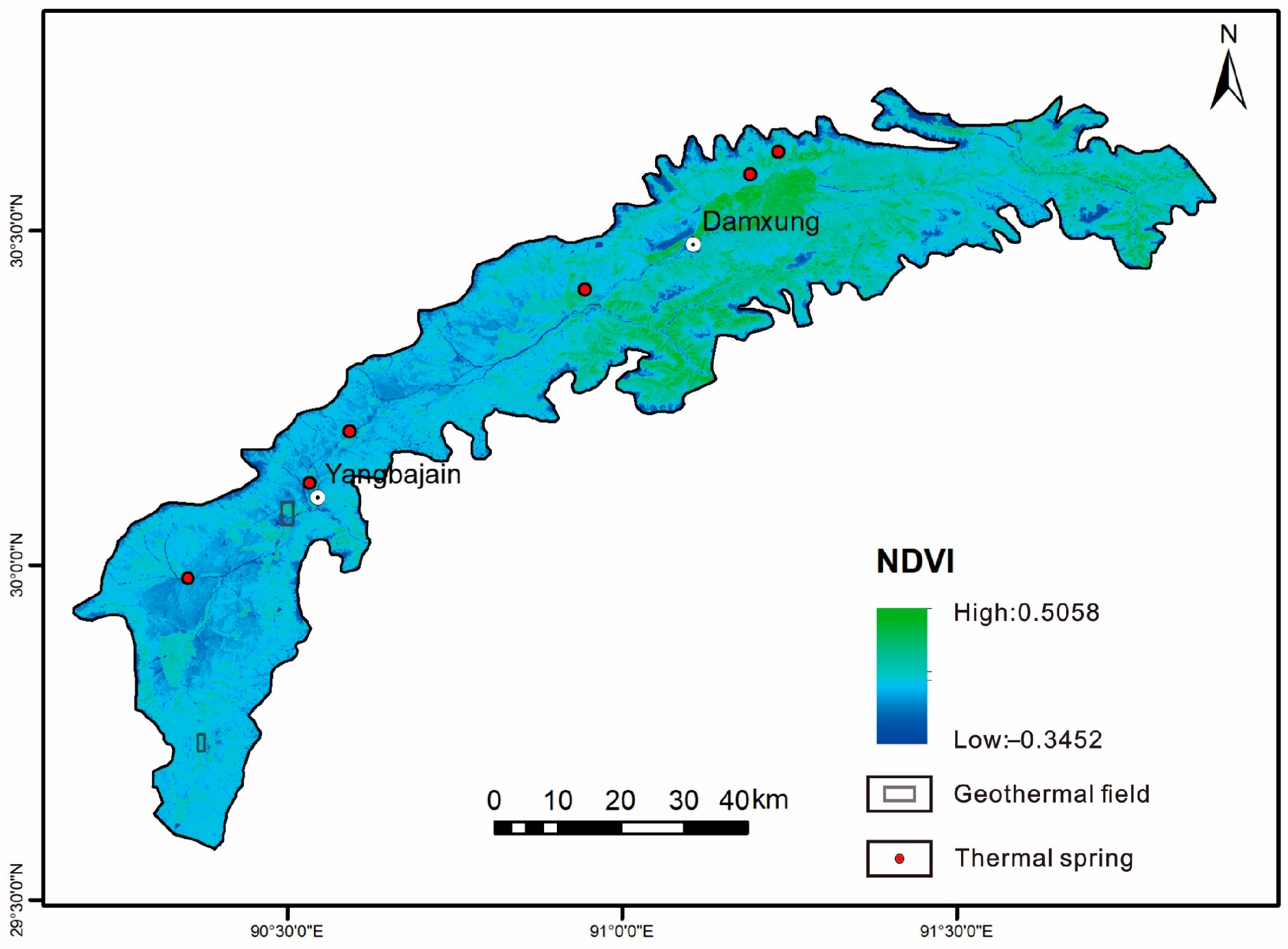
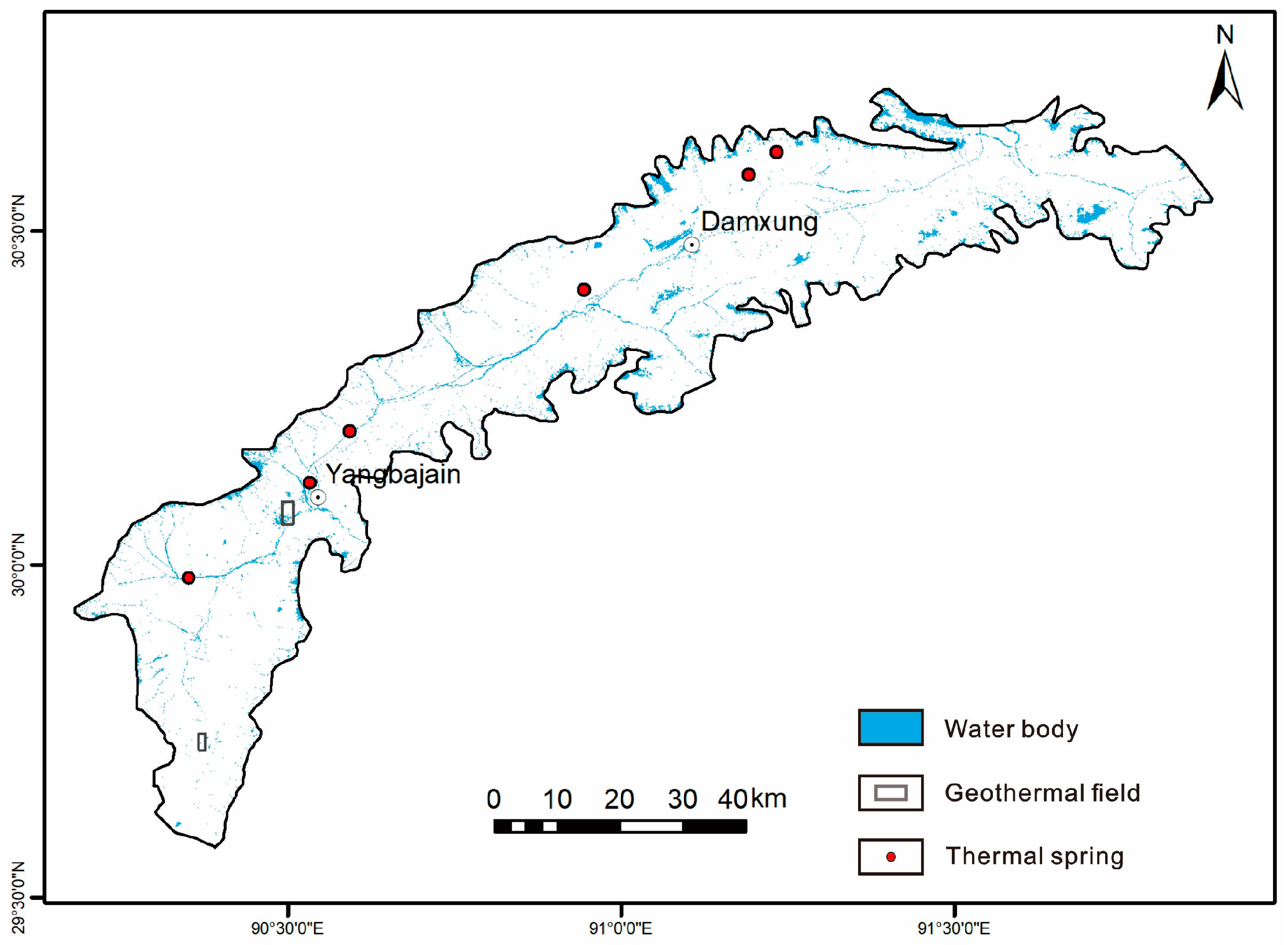
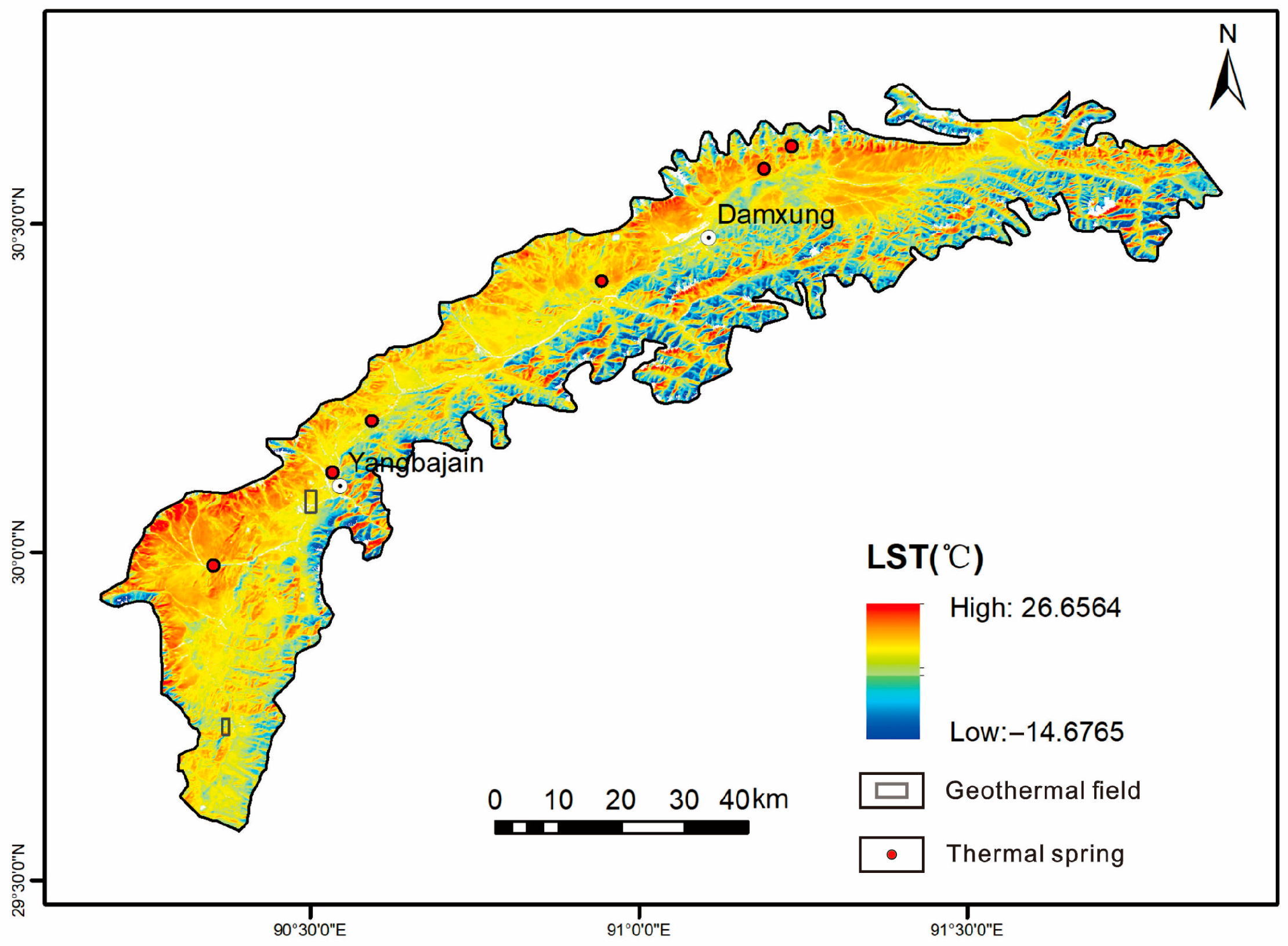
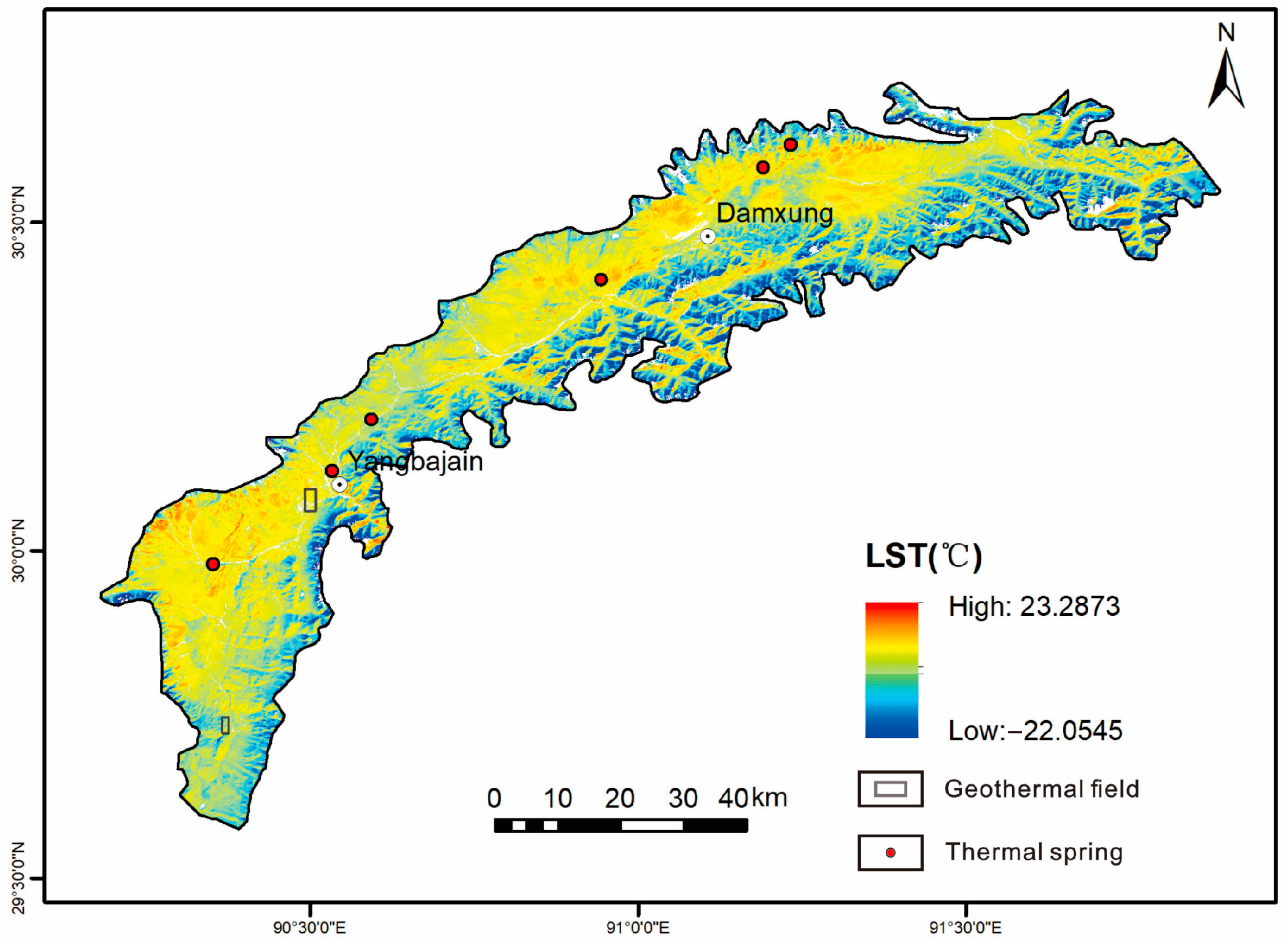

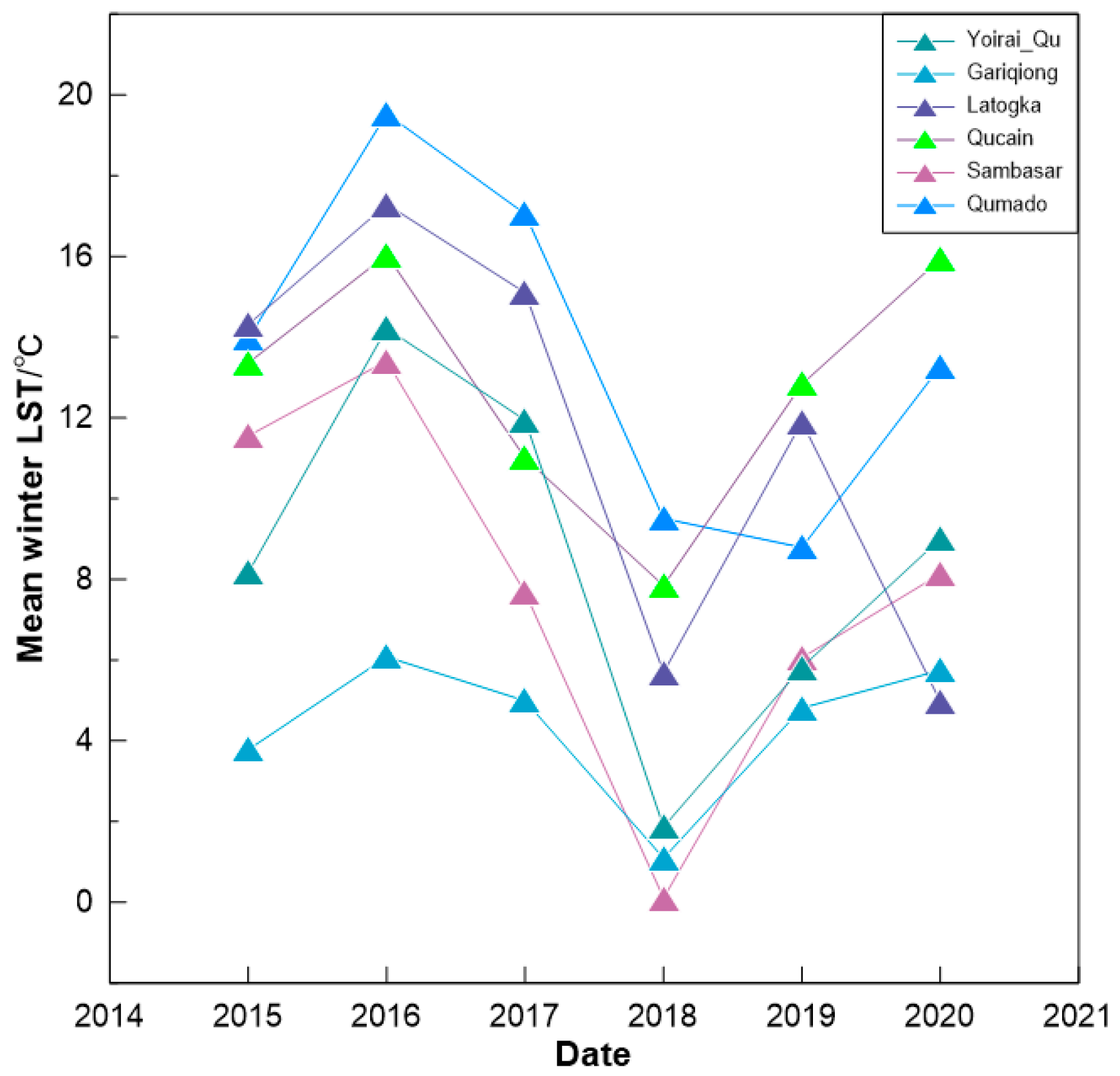

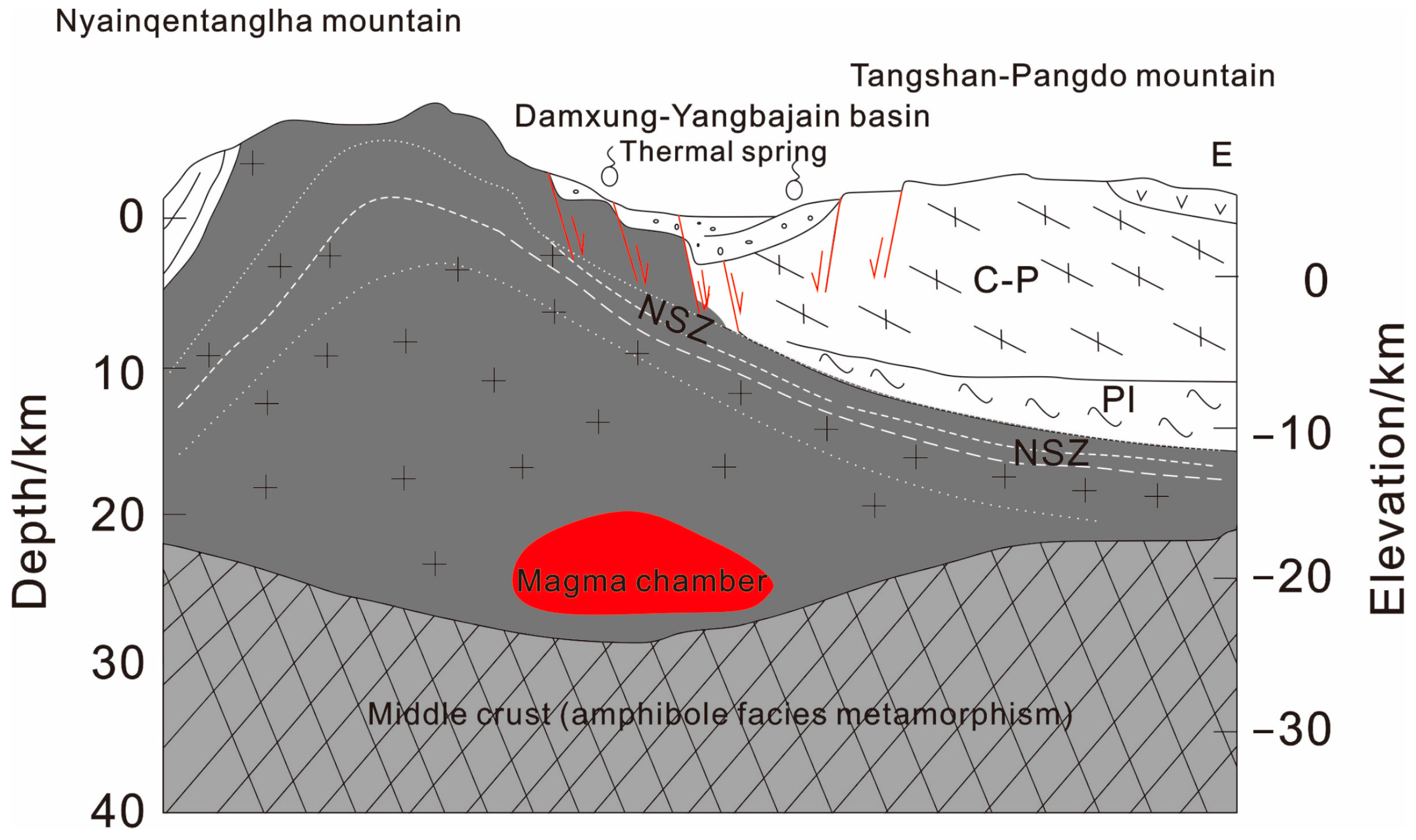
| Grade | LST Range/°C | Proportion/% | Pixel Numbers |
|---|---|---|---|
| The background area | −22.1~16.0 | 99.2504 | 5,318,582 |
| The weak LST anomaly area | 16.0~19.2 | 0.7255 | 38,878 |
| The medium LST anomaly area | 19.2~22.5 | 0.0237 | 1272 |
| The strong LST anomaly area | 22.5~23.3 | 0.0004 | 20 |
| Name | Type | Longitude | Latitude | Altitude |
|---|---|---|---|---|
| Yoirai Qu | hot spring | 91°14′00″E | 30°37′07″N | 4630 m |
| Qumado | tepid spring | 91°11′30″E | 30°35′05″N | 4550 m |
| Qucain | boiling spring | 90°56′40″E | 30°24′46″N | 4250 m |
| Latogka | hot spring | 90°35′35″E | 30°12′00″N | 4480 m |
| Sambasar | warm spring | 90°32′00″E | 30°07′20″N | 4330 m |
| Gariqiong | hot spring | 90°21′08″E | 29°58′50″N | 4400 m |
Disclaimer/Publisher’s Note: The statements, opinions and data contained in all publications are solely those of the individual author(s) and contributor(s) and not of MDPI and/or the editor(s). MDPI and/or the editor(s) disclaim responsibility for any injury to people or property resulting from any ideas, methods, instructions or products referred to in the content. |
© 2023 by the authors. Licensee MDPI, Basel, Switzerland. This article is an open access article distributed under the terms and conditions of the Creative Commons Attribution (CC BY) license (https://creativecommons.org/licenses/by/4.0/).
Share and Cite
Li, X.; Jiang, G.; Tang, X.; Zuo, Y.; Hu, S.; Zhang, C.; Wang, Y.; Wang, Y.; Zheng, L. Detecting Geothermal Anomalies Using Multi-Temporal Thermal Infrared Remote Sensing Data in the Damxung–Yangbajain Basin, Qinghai–Tibet Plateau. Remote Sens. 2023, 15, 4473. https://doi.org/10.3390/rs15184473
Li X, Jiang G, Tang X, Zuo Y, Hu S, Zhang C, Wang Y, Wang Y, Zheng L. Detecting Geothermal Anomalies Using Multi-Temporal Thermal Infrared Remote Sensing Data in the Damxung–Yangbajain Basin, Qinghai–Tibet Plateau. Remote Sensing. 2023; 15(18):4473. https://doi.org/10.3390/rs15184473
Chicago/Turabian StyleLi, Xiao, Guangzheng Jiang, Xiaoyin Tang, Yinhui Zuo, Shengbiao Hu, Chao Zhang, Yaqi Wang, Yibo Wang, and Libo Zheng. 2023. "Detecting Geothermal Anomalies Using Multi-Temporal Thermal Infrared Remote Sensing Data in the Damxung–Yangbajain Basin, Qinghai–Tibet Plateau" Remote Sensing 15, no. 18: 4473. https://doi.org/10.3390/rs15184473
APA StyleLi, X., Jiang, G., Tang, X., Zuo, Y., Hu, S., Zhang, C., Wang, Y., Wang, Y., & Zheng, L. (2023). Detecting Geothermal Anomalies Using Multi-Temporal Thermal Infrared Remote Sensing Data in the Damxung–Yangbajain Basin, Qinghai–Tibet Plateau. Remote Sensing, 15(18), 4473. https://doi.org/10.3390/rs15184473







